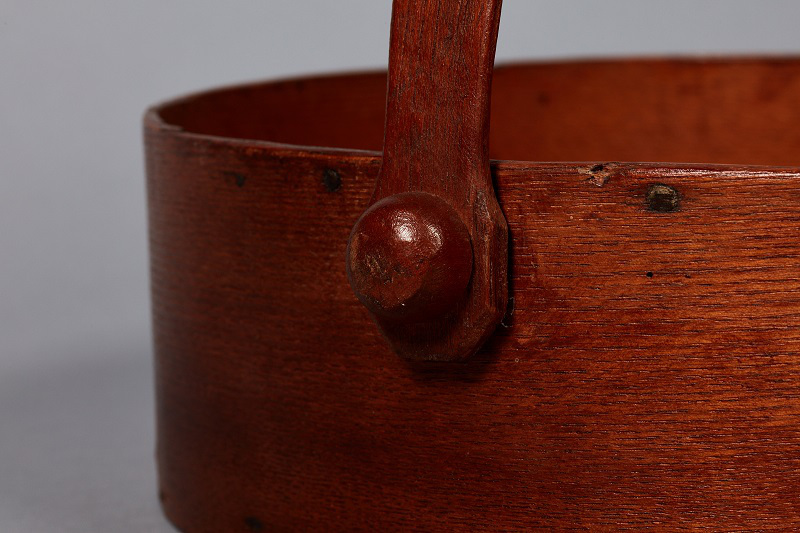
Round carrier of ash and white pine, made at Mount Lebanon’s Second Family. Detail views of the pin and locking pegs that fasten the swing handle to the rim. Shaker Museum | Mount Lebanon, 1993.3.7.
In 2016 Shaker Museum | Mount Lebanon received a $750,000 grant from The Henry Luce Foundation to create an online digital catalog of its collections. Work has been ongoing entering data about the museum’s object, archive, and library holdings and in March of this year, photography of the collections began. Boston-based photographer John Mulligan spent a […]

Set-up for collection digitization, March, 2017, Shaker Museum | Mount Lebanon
In 2016 Shaker Museum | Mount Lebanon received a $750,000 grant from The Henry Luce Foundation to create an online digital catalog of its collections. Work has been ongoing entering data about the museum’s object, archive, and library holdings and in March of this year, photography of the collections began. Boston-based photographer John Mulligan spent a week at the Shaker Museum’s Old Chatham campus, and photographed about 300 objects. He will continue this work one week per month over the next year, producing high quality digital images of the collection.

Oval boxes waiting to be photographed as part of the digitization project at Shaker Museum | Mount Lebanon, March, 2017.
Planning for photography began in February. Though staff at the museum have long created reference images of objects as part of the process of cataloging, it is not practical (or even, perhaps, desirable) to capture a high quality image of every piece in a collection that numbers over 56,000 objects. Staff had to ask: Which objects should be photographed by the professional, and for which do in-house images suffice? A number of factors come into play.
First the collection must be considered in terms of broad categories defined by both form and function. From these, objects are selected that comprise representative examples of the type. For example, included in the category of case furniture are chests of drawers, blanket chests, cupboards, and tailor counters. The range of activities associated with hat manufacture are represented by hat and brim molds, bonnet molds, patterns used to cut pieces of woven material into bonnet sections, and samples of woven straw and palm leaf. A survey of hand tools would include a selection of woodworking tools such as planes and cutters, metalworking tools such as punches and casting patterns, and leatherworking tools such as awls and shoe lasts.

Round carrier of ash and white pine, made at Mount Lebanon’s Second Family. Detail views of the pin and locking pegs that fasten the swing handle to the rim. Shaker Museum | Mount Lebanon, 1993.3.7.

Round carrier of ash and white pine, made at Mount Lebanon’s Second Family. Detail views of the pin and locking pegs that fasten the swing handle to the rim. Shaker Museum | Mount Lebanon, 1993.3.7.

Round carrier of ash and white pine, made at Mount Lebanon’s Second Family. Detail views of the pin and locking pegs that fasten the swing handle to the rim. Shaker Museum | Mount Lebanon, 1993.3.7.
Within specific object types, a number of criteria are considered as well. In examining each of the museum’s 75 or so oval boxes, the first group of objects that were photographed, staff asked: what is the significance of this object, or what story can it tell in terms of provenance or association? Special attention is paid to pieces with inscriptions, particularly names, such as the box labeled “Frederick W. Evans 1857” on the lid header. Does the box have particular aesthetic value in its paint color or finish, or type of wood used, when compared to the others? Is it unusually well executed when the cut of the swallowtails, the pattern or placement of the tacks, or the fit of headers to the rims are considered? It’s also important to be sure that as many Shaker communities as possible are represented, so that eventual visitors to the museum’s website can compare boxes made at Mount Lebanon, NY, Canterbury, NH, Sabbathday Lake, ME, and more.

Maple, red cedar and white pine oval box made at Mount Lebanon, with view of inscription on underside of lid header: “Frederick W. Evans 1857”. Shaker Museum | Mount Lebanon, 2009.2.1a,b.

Maple, red cedar and white pine oval box made at Mount Lebanon, with view of inscription on underside of lid header: “Frederick W. Evans 1857”. Shaker Museum | Mount Lebanon, 2009.2.1a,b.
The goals of the photography project are the same as that of the digitization project overall: to provide a powerful research tool for students and specialists of Shaker history; to facilitate access and promote loans and exhibitions of the works and objects; and to ensure that visitors to the website can explore the museum’s rich holdings from anywhere in the world. The project is scheduled to be completed at the end of 2018. Stay tuned to the museum’s blog to keep abreast of new developments.